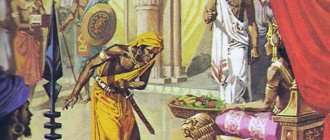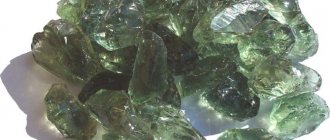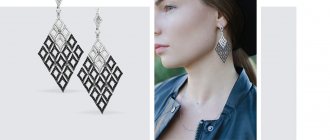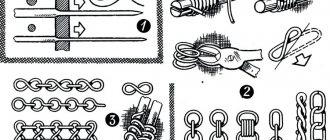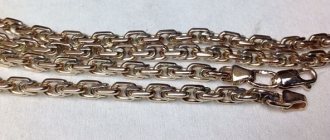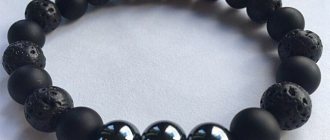Since ancient times, sparkling precious stones have been highly valued and were a sign of royal luxury.
Crystals shimmering in the sun's rays were used to decorate a variety of things.
They were inlaid with jewelry, clothing items, symbols of royal power, and were even used in burial rituals.
Many of the stones found in mines in the distant past have disappeared, leaving mention of themselves only in myths.
But some gems continue to amaze us with their beauty even now.
For example, the legendary Orlov diamond, which everyone can see in the Diamond Fund of the Russian Federation.
What does the stone look like?
The Orlov Diamond is the largest natural diamond ever found in India. It has a slightly greenish tint and is made in a rare “Indian rose” cut.
The master tried to convey the natural beauty of the diamond as accurately as possible, so he only polished its edges. The Orlov shape has about 180 faces. Due to the abundance of sides during grinding, the Orlov lost almost half of its natural weight, after which its weight was 189.62 carats.
Price
The price of a black diamond depends on its quality, weight, cut and color. Small stones of low quality are considered the cheapest. Their cost is $16-25 per carat. Specimens of average quality, subjected to heat treatment for color intensity, cost between $160-180 per carat. First grade Carbonado can be purchased for $500-650 per carat.
A pique diamond certified by the Gemological Institute of the United States costs $1,000-$3,000 per carat. Personalized crystals are several times more expensive.
Origin of the stone
At the turn of the 17th and 18th centuries, a 400-carat diamond was discovered in India. Historians believe that the diamond under the name of Count Orlov originally belonged to Shah Jehan.
Researchers draw parallels with the historical Great Mogul gemstone, suggesting that they are the same crystal. Another name for diamond is known, which has come down to us from ancient times: “Derianur”, which means “Sea of Light”.
After the death of Jehan, “Orlov” probably remained for a long time on the island of Srirangapatnam, decorating a statue near a Hindu temple. But he was not destined to remain in this form until the end of centuries.
Watch the video about diamond:
Therapeutic effect
Black diamond is a symbol of men's health. It strengthens male strength, increases potency and reproductive function.
The dark mineral also affects other organs and vital systems:
- normalizes the functioning of the digestive system;
- has a beneficial effect on the nervous system and psyche;
- helps overcome infectious processes;
- eliminates bad habits;
- eliminates fever;
- promotes a speedy recovery.
Since ancient times, black diamond has been used to improve hearing acuity.
Journey of the Wonderful Diamond
According to legend, one young man from Britain converted to Hinduism for the sake of the crystal and became a servant of the temple near which the statue was located. The young man did this in the hope of stealing the treasure and selling it.
After the Orlov diamond left India, its amazing story began. But it should be remembered that the accuracy of historical records cannot be fully confirmed. And around the precious stones that were touched by the hands of famous rulers, there are often many legends and speculations.
Magic properties
Like all dark stones, the black diamond is in demand among psychics, magicians and sorcerers. The mineral is used to communicate with otherworldly forces, perform rituals and improve one’s abilities.
A black diamond is considered a strong amulet that protects against dark forces, curses, the evil eye and damage. It increases spiritual and physical resistance to negative factors, enhances inner sense.
The stone is considered a talisman of successful people. It develops the makings of a leader, determination, and perseverance in achieving goals.
In a love relationship, a black diamond ignites feelings and bestows passion.
The most energetically powerful diamonds are those that are passed down through generations. If a gem is purchased or received as a gift, it will take time to activate it.
European Diamond History
For the first time in Europe, Orlov ended up in the hands of the Armenian merchant Gregory Safras. Gregory had never seen anything more beautiful than a diamond; he became eager to own the treasure and spent all his savings on it. But because of fear of pirates, instead of admiring the diamond, the merchant left it for safekeeping in the bank.
So the stone ended up in Amsterdam and even managed to acquire a new name corresponding to the city. After the death of the owner of “Amsterdam”, a relative of Safras, master of jewelry craft Ivan Lazarev, sold the diamond, concluding a profitable deal for 400 thousand rubles, which by those standards was a fortune.
Despite his closeness to the empress, Orlov was not a man of the greatest wealth. It is believed that for this reason the count himself could not acquire the stone.
But despite the circumstances, the diamond fell into the hands of the favorite of Catherine II, Grigory Grigorievich Orlov. Subsequently, a diamond was named after this man.
Storage and care
Black gold ring with black diamond
Despite the fact that a diamond has a maximum hardness rating, it is very fragile. Therefore, it should be protected from mechanical impact, especially sharp impacts and falling from a height onto a hard surface.
A stone of natural origin is not afraid of the sun and moisture, but it is still not recommended to leave it exposed to these factors for a long time.
To clean a black diamond you will need ammonia, water and a soft bristle brush. First, the stone is placed in hot water for 15-20 minutes. At this time, water and ammonia are diluted in a ratio of 3:1. The diamond or the product containing it is placed in the solution for 1 hour and periodically cleaned with a brush. After this, the mineral is rinsed, dried and polished with a piece of suede or woolen fabric.
Periodically, it is recommended to take the stone to a jewelry workshop for cleaning.
Precious gift to the Empress
The diamond came to Catherine II as a gift from the count on her name day.
Orlov knew about Catherine's passion for precious stones, he knew that his position at court was becoming less and less significant. It was increasingly difficult for him to compete with other favorites of the Empress, especially Count Potemkin. In order to regain Catherine’s favor, he did not skimp and presented her with such a surprise.
The notes of the Prussian Count Solms, who was present that evening, mentioned the events that took place at dinner. The Empress was surrounded by attention and respect, a festive atmosphere reigned everywhere, and guests greeted the hostess with gifts and flowers.
The Count also did not arrive empty-handed. Joyfully anticipating Catherine's smile and delight, Gregory made a gift. He turned out to be right, the empress liked the diamond.
The Empress liked the diamond so much that she ordered it to be enclosed in two rims of her scepter. But Catherine rejected the count himself, maintaining her former coldness towards him.
Physical and chemical characteristics
Chemically, a black diamond is pure carbon. The black color is provided by impurities of graphite, magnetite, hematite and other minerals.
Physical properties:
| Index | Description |
| Mohs hardness | 10 units |
| Density | 3.47-3.55 g/cm³ |
| Fragility | High |
| Shine | Matte |
| Transparency | Translucent, fully opaque |
| Color | Smoke, dark gray, dark green, dark brown, black, charcoal |
| Structure | Porous |
| Kink | Uneven, conchoidal |
| Cleavage | Perfect |
| Refractive index | 2,417-2,421 |
| Melting temperature | From 3800°C |
| Magnetism | Present |
Black diamonds are not characterized by absolute transparency and glassy luster. In most cases, defects can be found in the structure of stones.
Myths and reality
Another precious stone is known under the name “Orlov diamond”. It is distinguished by its black color and a more mysterious origin story. Even the name of the true owner of the gem is not known to this day.
There is a legend that the stone was kept in the eye socket of one of the idols at an Indian temple. And having once been kidnapped, he began to “take revenge” on all subsequent owners, bringing them only grief and misfortune.
It is possible that the first owner of the dark diamond was Nadezhda Orlova, from whom it got its name. But the story of her life is no less mysterious and has not been reliably established.
There were rumors that girls committed suicide because of the diamond. After the death of the two owners of the black diamond, Princess Golitsyna-Baratynskaya and Maria Leshchinskaya, it was decided to split Orlov. Only the largest rectangular fragment has survived to this day.
Unique black diamonds
Black diamond Orlov photo
Black Orlov” is indeed a very unusual and rare crystal. Experts are well aware that it is quite difficult to find in nature a mineral of such color and size that would allow it to be cut into jewelry. The difficulty in processing such samples also lies in the fact that its crystal structure has its own characteristics. We can say that it consists of separate small parts, which forces it to lose more than half its weight during cutting.
The gem received its mysterious color due to the presence of a significant amount of graphite or hematite in the composition. Typically, these inclusions are located unevenly in the crystal, which causes the stone to become cloudy and dull. But if their placement is ordered, then the diamond acquires the ability to shine intensely, reflecting rays of light. These are precisely the qualities that “Black Orlov” possesses, whose radiance is no less bright compared to well-known diamonds of familiar shades.
And if before the appearance of “Black Orlov” there was little interest in stones of this shade, then after the demonstration of this extraordinary crystal, jewelers began to actively use such minerals in their work, creating luxurious jewelry.
Diamond “Shah” – “brother” of “Orlov”
Unlike the Orlov, the Shah was not cut and therefore is not considered a diamond. The stone has the shape of an irregular octahedron, with dimensions of 3 cm and 88 grams. The crystal has unique characteristics; on the edges there are three inscriptions with the names of previous owners.
Almaz, like “Orlov,” came to us from India, where he remained for a long time, only changing owners. It belongs to precious stones that, in addition to their physical properties, have a long and fascinating history.
The Orlov diamond is a unique diamond. Its edges are literally overgrown with history and, thanks to this cutting, it has become a more valuable and interesting specimen.
Would you go to the Diamond Fund exhibition to see the Orlov diamond with your own eyes? Share the article on social networks to spread useful information.
Diamond "Orlov" presented to Empress Catherine
Ekaterina and Orlov
And now begins that part of the story, thanks to which this outstanding diamond gained its name and became famous throughout the world. According to one version, the Second Count Grigory Orlov, who had fallen out of favor with Empress Catherine, decided to regain her favor by presenting her with a luxurious gift. He bought this jewel from one of the heirs of the merchant Safras and without delay brought it to the court.
There is another version, according to which Empress Catherine, having heard about the famous stone from India, wanted to get it. Having bought it for a lot of money, she decided to do it in such a way as not to give any reason for gossip among her retinue. The clever ruler gave it to Count Orlov, asking him to present the stone to her for the upcoming name day. The favorite fulfilled her will and gave her a gorgeous crystal.
Historians do not give exact data whether Orlov himself bought the diamond, or whether it was the initiative of the empress. But, nevertheless, this sparkling gem began to decorate the scepter, which is one of the regalia of the ruling dynasties. Jewelers did not change the cut, so even now everyone can admire the amazing work of ancient masters.
